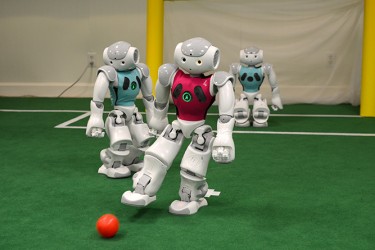

Becca Magrino // Contributing Photographer
For the past four summers, computer science professor Ubbo Visser has lead a team of University of Miami students around the world to take part in high-stakes soccer competitions.
But the actual players for the RoboCanes are autonomous humanoid robots, programmed by the students for tournaments such as the RoboCup, the equivalent of FIFA’s World Cup.
“In 2008, I came to UM from Germany, and since I had been working with the humanoid robots at my previous school, I decided to try and start a team here,” Visser said. “Each member of the team is responsible for a different aspect of the robot. It’s such a complex problem to solve, but when we attend the competitions around the world, it’s one of the greatest experiences a student can have.”
The robots used in the RoboCup Standard Platform League are kid-sized and can run, pass and shoot with their human-like bodies. All of the teams have to use the same type of robots, but users can customize them with their own software and artificial intelligence (AI) systems, which determine behavior and functioning.
Through the AI systems, the robots operate without remote controllers or any human interaction during the matches. So the better a team programs its robots to operate independently, the better they play.
Andreas Seekircher, a Ph.D. student and member of the RoboCanes, works on the “lower-level” operations of the robots, which includes running and balance.
“What makes this so different from video games is that these are physical robots that rely on real physics,” he said. “If one joint doesn’t work correctly, the whole thing will fail.”
Once the match has begun, the robots must identify and react to the ever-changing environment of a soccer game in mere fractions of a second, just as humans do. This event describes the robots’ “upper-level” functions.
“When we play sports, our brains predict very quickly what will happen next – where the ball will be and where we need to move,” said Saminda Abeyruwan, another Ph.D. student and team member. “I want to implement those predictive abilities into the robots.”
Team members say the tournaments are extremely competitive. Since 2010, the RoboCanes team has played in the 3-D Soccer Simulation League, which uses AI systems and software on a computer-simulated robots. They won the 2011 German Cup and were a runner-up in the 2012 RoboCup in Mexico.
Since 2012, the RoboCanes have also been playing in the Standard Platform League, which pits two teams of five robots that race around a 9-meter by 6-meter field to try and score goals.
Visser believes that having more students on the team would make it stronger. Autonomous robotic systems, or CSC 668/597, is a class offered by the computer science department that works with the robots. Although it may sound rather intimidating for some students, the team members insist that everyone is welcome and taking the class is not required.
The teams can have as many members as they want since it is a research venture. For the Ph.D. students, their work represents the basis of their doctoral theses.
While competing in tournaments is fun, Visser and his students have much larger aspirations for these robots.
“Soccer is so dynamic, and the players have so many decisions to make. If a robot can do this, then hopefully they can one day be sent into a dangerous situation such as a burning building, rather than sending in humans.”
For more information on the RoboCanes team, contact Visser at visser@miami.edu.





